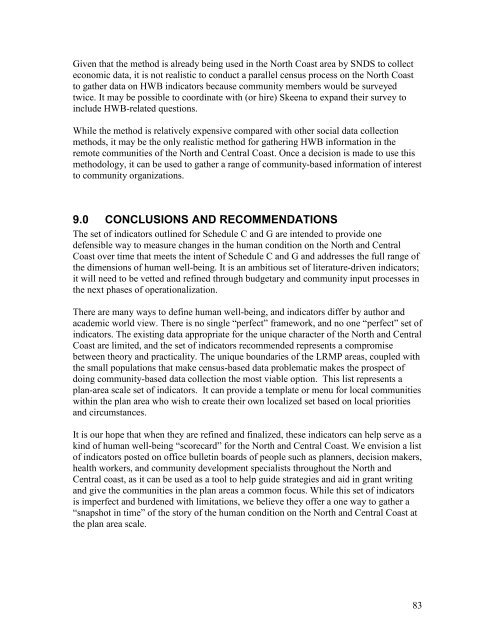Final report - Integrated Land Management Bureau
Final report - Integrated Land Management Bureau
Final report - Integrated Land Management Bureau
You also want an ePaper? Increase the reach of your titles
YUMPU automatically turns print PDFs into web optimized ePapers that Google loves.
Given that the method is already being used in the North Coast area by SNDS to collect<br />
economic data, it is not realistic to conduct a parallel census process on the North Coast<br />
to gather data on HWB indicators because community members would be surveyed<br />
twice. It may be possible to coordinate with (or hire) Skeena to expand their survey to<br />
include HWB-related questions.<br />
While the method is relatively expensive compared with other social data collection<br />
methods, it may be the only realistic method for gathering HWB information in the<br />
remote communities of the North and Central Coast. Once a decision is made to use this<br />
methodology, it can be used to gather a range of community-based information of interest<br />
to community organizations.<br />
9.0 CONCLUSIONS AND RECOMMENDATIONS<br />
The set of indicators outlined for Schedule C and G are intended to provide one<br />
defensible way to measure changes in the human condition on the North and Central<br />
Coast over time that meets the intent of Schedule C and G and addresses the full range of<br />
the dimensions of human well-being. It is an ambitious set of literature-driven indicators;<br />
it will need to be vetted and refined through budgetary and community input processes in<br />
the next phases of operationalization.<br />
There are many ways to define human well-being, and indicators differ by author and<br />
academic world view. There is no single “perfect” framework, and no one “perfect” set of<br />
indicators. The existing data appropriate for the unique character of the North and Central<br />
Coast are limited, and the set of indicators recommended represents a compromise<br />
between theory and practicality. The unique boundaries of the LRMP areas, coupled with<br />
the small populations that make census-based data problematic makes the prospect of<br />
doing community-based data collection the most viable option. This list represents a<br />
plan-area scale set of indicators. It can provide a template or menu for local communities<br />
within the plan area who wish to create their own localized set based on local priorities<br />
and circumstances.<br />
It is our hope that when they are refined and finalized, these indicators can help serve as a<br />
kind of human well-being “scorecard” for the North and Central Coast. We envision a list<br />
of indicators posted on office bulletin boards of people such as planners, decision makers,<br />
health workers, and community development specialists throughout the North and<br />
Central coast, as it can be used as a tool to help guide strategies and aid in grant writing<br />
and give the communities in the plan areas a common focus. While this set of indicators<br />
is imperfect and burdened with limitations, we believe they offer a one way to gather a<br />
“snapshot in time” of the story of the human condition on the North and Central Coast at<br />
the plan area scale.<br />
83
















